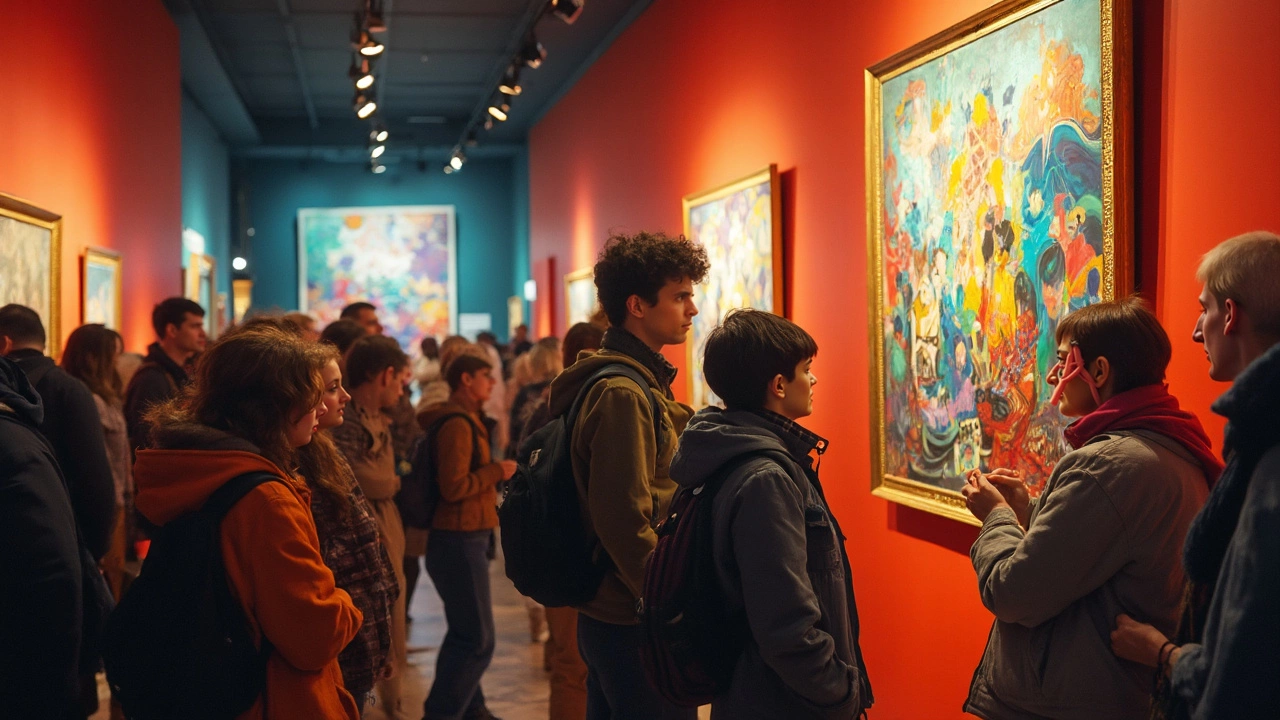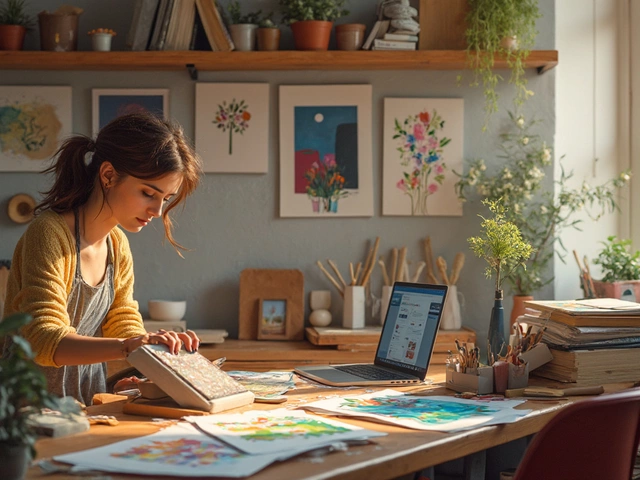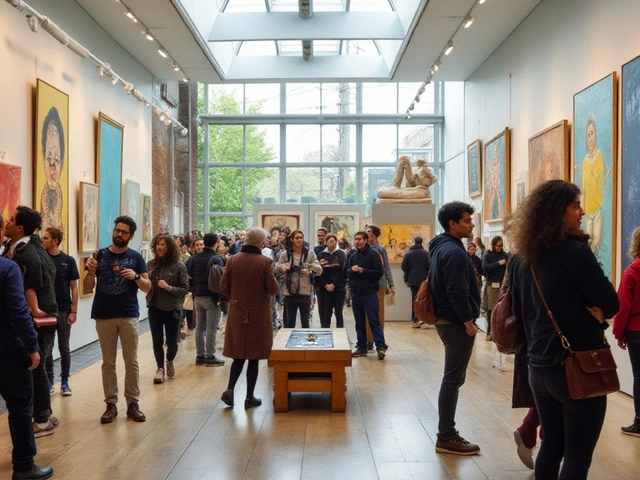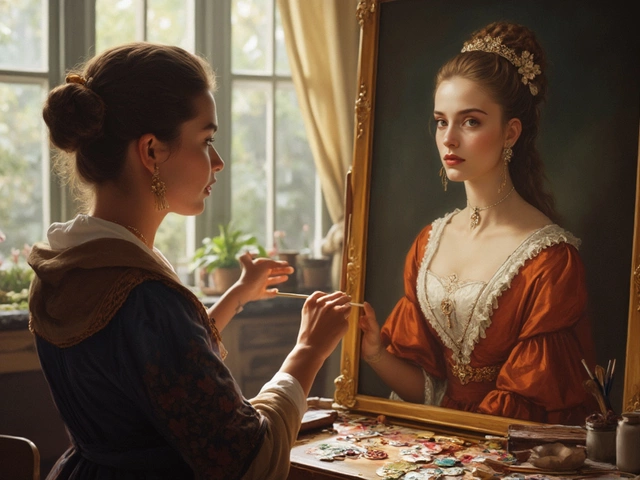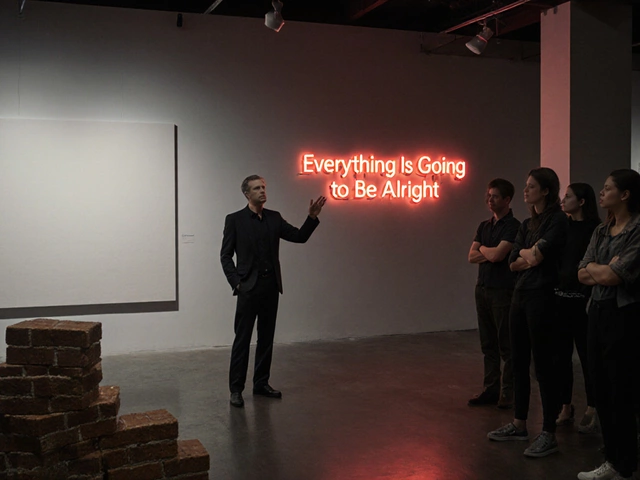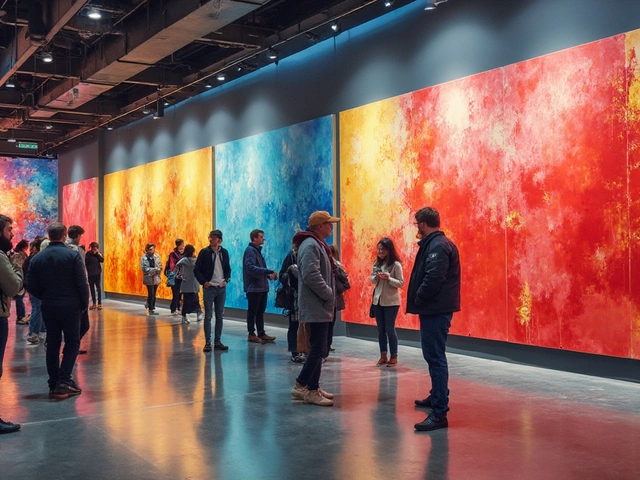Ever stand in front of a piece of modern art and think, "Is someone pulling my leg?" You’re not the only one. The thing is, modern art has this way of dividing people—one person sees genius, someone else just sees a mess. But there’s more going on here than meets the eye.
First, modern art isn’t about matching the sofa or looking pretty. It’s about ideas, emotions, and sometimes even poking fun at the whole idea of art itself. Remember that time a banana was taped to a wall and sold for over $100,000? Some call it a prank, others call it a breakthrough. The truth is, how you see modern art has a lot to do with your own experiences and what you bring to the table. So if abstract shapes and splashes of color leave you baffled, that’s normal.
The best way to start making sense of modern art? Ask yourself, “What is this making me feel?” or, “What could the artist be saying here?” Instead of looking for a clear picture, look for the message, the joke, or even the boldness of the whole thing. The point isn’t always to understand every detail, but to have a personal reaction—awkward or inspired, it all counts.
- Why Modern Art Gets Such Strong Reactions
- The Psychology Behind What We See
- How to Approach Modern Art Without Feeling Lost
- Common Misconceptions (and Why They Stick)
- What Makes Certain Pieces So Valuable?
- Tips to Make Your Next Gallery Visit Fun
Why Modern Art Gets Such Strong Reactions
Maybe you’ve heard people say, “I could do that!” when looking at a splashy painting or a pile of bricks in a gallery. That’s classic — modern art tends to stir up big feelings. Some folks walk away amazed and maybe a little jealous. Others just roll their eyes. There’s a simple reason: modern art broke almost every rule people were used to. Before the late 1800s, most artists aimed to paint things the way they looked in real life. Then suddenly, art started looking wild, weird, and unfinished on purpose.
One famous moment: The 1917 exhibit where Marcel Duchamp showed off a plain urinal and called it “Fountain.” That piece caused a ton of outrage. People asked, “How is this even art?” Moments like this keep happening. They challenge what people expect and sometimes make them uncomfortable. That’s pretty much the point.
Modern art also forces you out of your comfort zone. Instead of handing you the message on a silver platter, it makes you fill in the blanks. That’s why walking into a gallery can feel like talking to someone who only answers with riddles. Not everyone is up for it – and that’s okay. The reactions come from this unfamiliar territory, mixed with the simple truth that not every piece is meant for everyone.
But here’s the odd twist: the stronger the reaction, the more it seems to stick in your mind. Experts actually track how controversial artwork can turn into long-term classics. Picasso’s “Les Demoiselles d’Avignon” was hated when it first appeared, but later people called it a masterpiece. It’s almost like outrage is part of the recipe for what makes modern art famous – or infamous.
The Psychology Behind What We See
Here’s something wild—how we look at modern art is actually shaped by how our brains work. It’s not just about seeing a red square or a drippy canvas. Our brains are always making guesses, connecting dots, and trying to make sense of things, even when the painting looks random.
There’s a study from Yale University that showed most people spend less than 30 seconds looking at a piece of modern art. Why so quick? Your brain grabs the basics, tries to spot patterns, then jumps to the next thing if it can’t figure out a story right away.
Unlike classic portraits or landscapes, modern art often skips the usual details. This forces folks to fill in the blanks themselves. That’s why one person might see a sunrise, and another sees a pile of laundry. Our backgrounds, moods, and even what we had for lunch can influence what pops into our heads when we face modern art.
Science backs this up. Here’s what usually happens when someone encounters abstract art:
- Your eyes scan for something familiar (a shape, a color, a line).
- If nothing clicks, your brain starts to get creative—imagining meanings or feelings.
- Sometimes this triggers a strong emotional response; curiosity, confusion, even annoyance.
- You might move on, or you might stick around to see what others are saying.
People who visit art galleries often get more comfortable with this process, especially after practicing a few times. Researchers at University College London found that even art newbies can start picking up details and meaning after just three or four paintings.
| What Shapes Your Reaction? | How It Affects You |
|---|---|
| Your own memories | You see connections others miss |
| Cultural background | Some colors or shapes have deeper meaning |
| Current mood | Feeling happy or stressed can totally change what you notice |
| Peer influence | Comments from friends can re-wire your first impression |
So if you feel clueless staring at a modern painting, don’t stress. Your reaction is shaped by real science, not just taste or art know-how. Next time, pay attention to that first gut feeling—that’s your brain doing what it does best, even if it doesn’t always make sense right away.
How to Approach Modern Art Without Feeling Lost
So you’re staring at a bright square, splashes, or some odd sculpture and thinking, “Now what?” The trick isn’t to pretend you know what’s going on—it’s to drop the pressure to guess some secret meaning. Modern art often ditches the obvious for something way more personal. Still, there are some smart ways to get more out of the experience—even if you’re totally new to it.
First, know that even the pros sometimes scratch their heads at modern art. Museums like MoMA in New York or Tate Modern in London are packed with people taking their time, doubling back, or just sitting and staring for a while. That’s normal. Nobody walks in an expert.
- Modern art isn’t made to deliver all the answers. The artist might want you to feel confused, laugh, or even get a little annoyed. That’s part of the experience.
- Read the title and the info card. Sometimes the year or even a one-sentence description can give a huge clue about what’s going on or why it was made.
- Don’t try to “get it” right away. Some pieces are about the process, or the artist’s mood, or a protest—sometimes it’s really about having a reaction, not solving a puzzle.
- If you’re with a friend, talk about what you both see. You’ll probably have different ideas, and that’s kind of the point. One exhibit at the Centre Pompidou in Paris showed that visitors spend an average of just 30 seconds per artwork, but conversation doubles that time and makes memories stick.
- If you can, check out what critics or the museum tour guides have to say, but remember—your take is just as valid. There’s not just one "right" answer.
- Notice your own gut reaction. Maybe you feel bored, maybe something bugs you, or maybe you unexpectedly like the color combo. Modern art is meant to be experienced as much as understood.
The best part? There’s no pop quiz at the end. Every reaction counts, and you might even find pieces that surprise you the more you think about them.
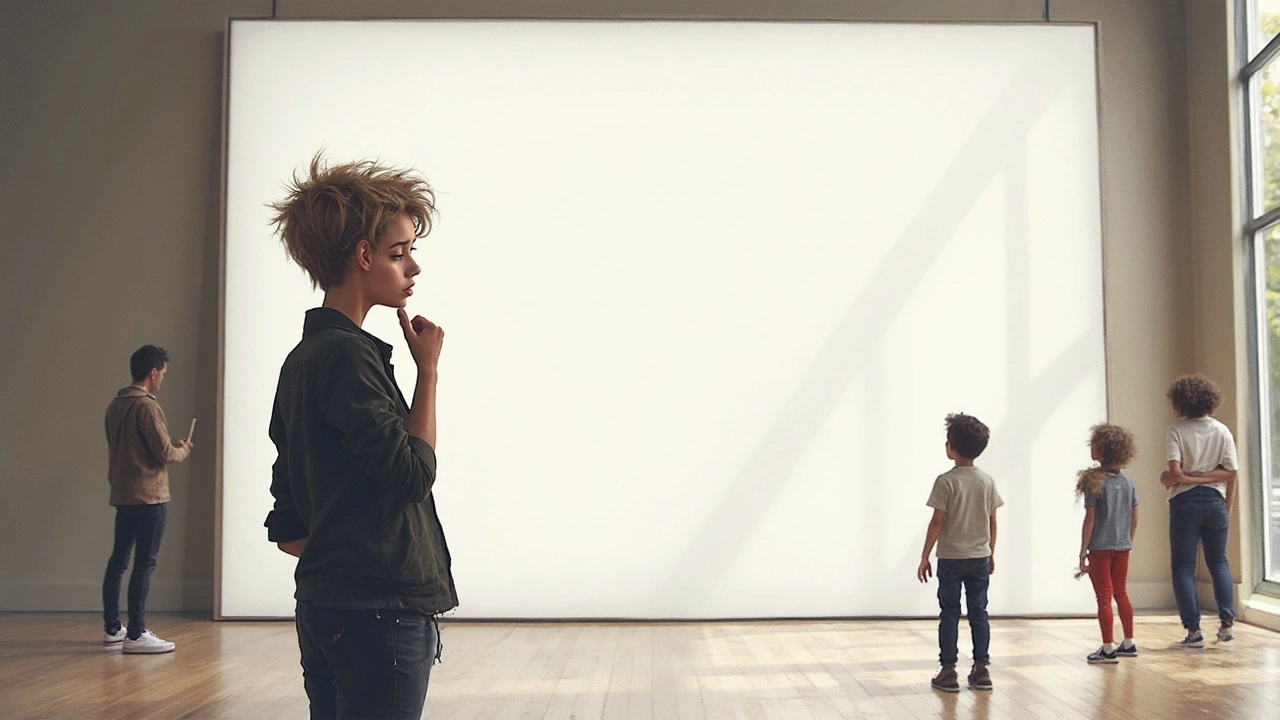
Common Misconceptions (and Why They Stick)
If you’ve ever heard someone say, “My kid could paint that,” or “Modern art is just random scribbles,” you’re not alone. These are probably the most common myths that float around the world of modern art. Why do they keep coming up?
Let’s take them apart. First, there’s the idea that modern artists aren’t skilled. It’s a hard myth to kill, but many famous modern artists (like Picasso and Kandinsky) could paint traditional portraits perfectly as kids and teens. They chose to break the rules once they’d already mastered them. Modern art isn’t a shortcut—it’s a new direction on purpose.
Another big one: "It’s just about shocking people." Sure, some works go for shock value, but most are focused on new ideas and ways to see the world. For instance, in 1917, Marcel Duchamp put a urinal in a gallery and called it art. It wasn’t just to get a rise out of people—he wanted to ask, “What counts as art?” That question still gets debated in art schools today.
There's also a money myth: People think modern art is valued for the hype, not the skill or meaning. The reality is, the prices come from a mix of history, rarity, artist reputation, and sometimes, market trends (just like classic cars, really).
Take a look at some quick numbers from recent modern art sales, just to bust that myth that only "pretty" things sell:
| Artwork | Artist | Year Sold | Price (USD) |
|---|---|---|---|
| Number 17A | Jackson Pollock | 2016 | $200 million |
| Rabbit | Jeff Koons | 2019 | $91.1 million |
| Untitled | Jean-Michel Basquiat | 2017 | $110.5 million |
So, why do these misconceptions stick around? Modern art challenges what people expect. It’s not always friendly or easy to explain in words, and that can make folks defensive. But if you know some facts, you see there’s usually a method behind the madness—even if it’s not what you imagined.
- Don’t judge too quickly—dig into what the artist was about.
- Look for interviews or clues from the artist (labels, titles, even social media these days).
- Ask a museum worker or guide for context; sometimes one story flips your whole take on a piece.
What Makes Certain Pieces So Valuable?
You see headlines about abstract paintings selling for tens of millions and sometimes wonder if the world’s lost its mind. So why are some pieces of modern art worth a fortune while others go unnoticed?
It’s not just about looks. Value comes from a mix of things, and sometimes it’s not what you expect:
- Artist’s Reputation: Big names like Jackson Pollock, Mark Rothko, or Jean-Michel Basquiat carry heavy weight. If an artist changed the way people see art, their work usually holds more value. For example, Basquiat’s ‘Untitled’ sold for over $110 million in 2017.
- Historical Impact: Pieces that started movements or shaped culture pack extra value. Think of Picasso’s ‘Les Demoiselles d’Avignon’—it wasn’t just a painting but a game changer for the whole art scene.
- Rarity: Fewer pieces from a particular artist or movement mean more competition. It's simple supply and demand: only one ‘Marilyn Diptych’ by Warhol exists.
- Provenance: That’s a fancy word for history of ownership. If a painting hung in a famous gallery or belonged to a big collector, buyers see it as more important—and more expensive.
- Condition: If a painting’s been well cared for, with bright colors and little damage, it’s worth more. Restorations can hurt value, especially if not done professionally.
- Market Hype: Sometimes the art world just gets obsessed. Media buzz, record-breaking auctions, or trendy collectors can shoot a price sky-high.
Money isn’t always logical in this world. Value can come from a gut feeling, a cool backstory, or simply being in the right place at the right time. If you ever wonder what the fuss is about, try reading up on the artist’s life or checking out auction results online—sites like Christie’s and Sotheby’s keep public sales info. It gives you surprising insight into what drives the wild numbers.
Tips to Make Your Next Gallery Visit Fun
If you've ever wandered around a modern art museum feeling out of place, don't sweat it—there are some straight-up useful tricks to get more from your visit and actually have a good time.
- Modern art is best seen up close. Sometimes brushstrokes, textures, or little details aren’t immediately obvious. Get in there (but not too close—alarms are no joke) and see what you might miss from a distance.
- Don’t rush. Most people spend around 10 seconds looking at a painting, but just doubling that time can help you notice things others miss. If you don’t get it, that’s fine—move on and focus on a piece that catches your eye.
- Snap a few photos (if the gallery allows it). Later, try to remember what you felt or thought when you first saw the work. Reactions—surprise, confusion, even boredom—are all part of the experience.
- Chat with staff or docents. They usually love talking about why certain works are important or what the artist’s backstory is. Sometimes a tiny detail will click and totally change how you see the piece.
- If an artwork seems extra weird or famous, search for it on your phone while you’re there. Museums like MoMA in New York and Tate Modern in London actually encourage this since it gets visitors more curious and involved.
If you like numbers, here's a snapshot of typical gallery stats:
| Average visit length | Time spent per artwork | % who use audio guides | Most visited art museum (2024) |
|---|---|---|---|
| 90 minutes | 20 seconds | 37% | Louvre, Paris |
Try using an audio guide if it’s offered—they often share stuff you can’t find anywhere else, like why a banana stuck to a wall was the talk of Art Basel. Or join a quick tour group if you spot one; you’ll probably learn one wild fact that sticks with you way longer than a label on the wall.
Main thing to remember: you don’t have to “get” everything. Let yourself enjoy a piece, laugh at something odd, or admit you don’t see the big deal. That’s half the fun.
